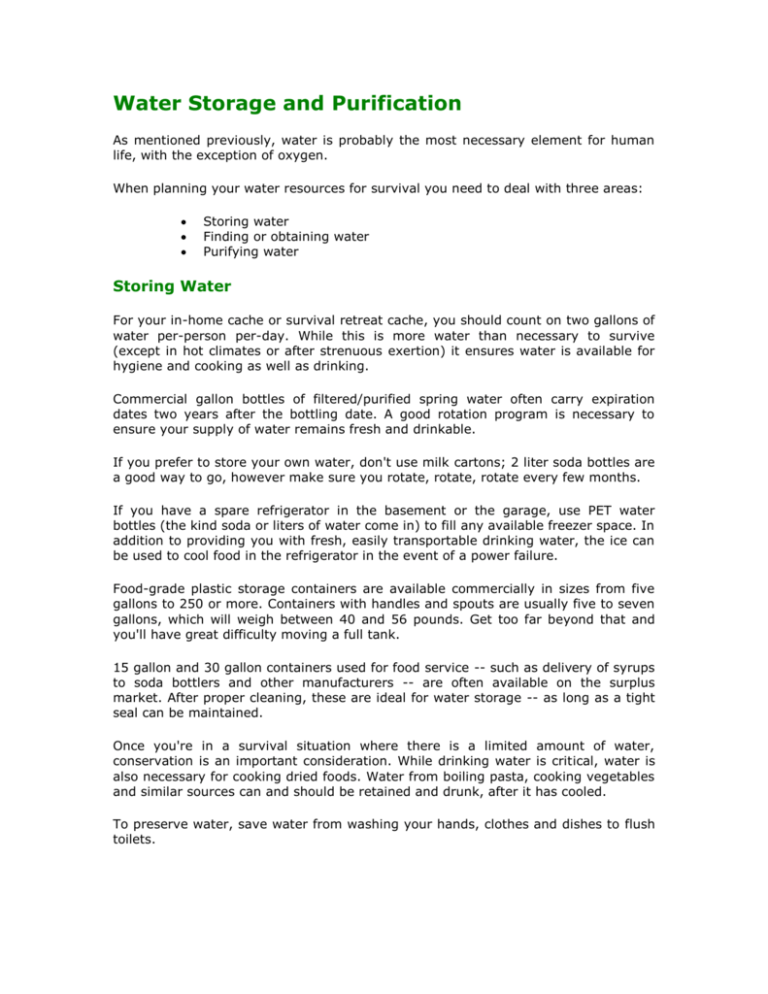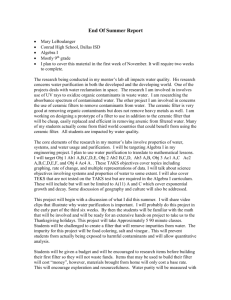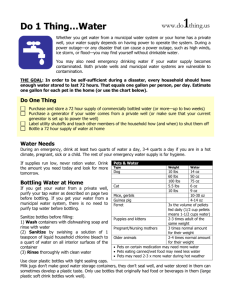Water Storage and Purification
advertisement

Water Storage and Purification As mentioned previously, water is probably the most necessary element for human life, with the exception of oxygen. When planning your water resources for survival you need to deal with three areas: Storing water Finding or obtaining water Purifying water Storing Water For your in-home cache or survival retreat cache, you should count on two gallons of water per-person per-day. While this is more water than necessary to survive (except in hot climates or after strenuous exertion) it ensures water is available for hygiene and cooking as well as drinking. Commercial gallon bottles of filtered/purified spring water often carry expiration dates two years after the bottling date. A good rotation program is necessary to ensure your supply of water remains fresh and drinkable. If you prefer to store your own water, don't use milk cartons; 2 liter soda bottles are a good way to go, however make sure you rotate, rotate, rotate every few months. If you have a spare refrigerator in the basement or the garage, use PET water bottles (the kind soda or liters of water come in) to fill any available freezer space. In addition to providing you with fresh, easily transportable drinking water, the ice can be used to cool food in the refrigerator in the event of a power failure. Food-grade plastic storage containers are available commercially in sizes from five gallons to 250 or more. Containers with handles and spouts are usually five to seven gallons, which will weigh between 40 and 56 pounds. Get too far beyond that and you'll have great difficulty moving a full tank. 15 gallon and 30 gallon containers used for food service -- such as delivery of syrups to soda bottlers and other manufacturers -- are often available on the surplus market. After proper cleaning, these are ideal for water storage -- as long as a tight seal can be maintained. Once you're in a survival situation where there is a limited amount of water, conservation is an important consideration. While drinking water is critical, water is also necessary for cooking dried foods. Water from boiling pasta, cooking vegetables and similar sources can and should be retained and drunk, after it has cooled. To preserve water, save water from washing your hands, clothes and dishes to flush toilets. Short Term Storage People who have electric pumps drawing water from their well have learned the lesson of filling up all available pots and pans when a thunderstorm is brewing. What would you do if you knew your water supply would be disrupted in an hour? Here are a few options in addition to filling the pots and pans: The simplest option is to put two or three heavy-duty plastic trash bags (avoid those with post-consumer recycled content) inside each other. Then fill the inner bag with water. You can even use the trash can to give structure to the bag. (A good argument for keeping your trash can fairly clean!) Fill your bath tub almost to the top. While you probably won't want to drink this water, it can be used to flush toilets, wash your hands, etc. If you are at home, a fair amount of water will be stored in your water pipes and related system. To get access to this water, first close the valve to the outside as soon as possible. This will prevent the water from running out as pressure to the entire system drops and prevent contaminated water from entering your house. Then open a faucet on the top floor. This will let air into the system so a vacuum doesn't hold the water in. Next, you can open a faucet in the basement. Gravity should allow the water in your pipes to run out the open faucet. You can repeat this procedure for both hot and cold systems. Your hot water heater will also have plenty of water inside it. You can access this water from the valve on the bottom. Again, you may need to open a faucet somewhere else in the house to ensure a smooth flow of water. Sediment often collects in the bottom of a hot water heater. While a good maintenance program can prevent this, it should not be dangerous. Simply allow any stirred up dirt to again drift to the bottom. Finding or Obtaining Water There are certain climates and geographic locations where finding water will either be extremely easy or nearly impossible. You'll have to take your location into account when you read the following. Wherever you live, your best bet for finding a source of water is to scout out suitable locations and stock up necessary equipment before an emergency befalls you. With proper preparedness, you should know not only the location of the nearest streams, springs or other water source but specific locations where it would be easy to fill a container and the safest way to get it home. Preparedness also means having at hand an easily installable system for collecting rain water. This can range from large tarps or sheets of plastic to a system for collecting water run off from your roof or gutters. Once you have identified a source of water, you need to have bottles or other containers ready to transport it or store it. Purification And while you may think any water will do in a pinch, water that is not purified may make you sick, possibly even killing you. In a survival situation, with little or no medical attention available, you need to remain as healthy as possible. And a bad case of the runs is terribly uncomfortable in the best of times! Boiling water is the best method for purifying running water you gather from natural sources. It doesn't require any chemicals, or expensive equipment -- all you need is a large pot and a good fire or similar heat source. Plus, a rolling boil for 20 or 30 minutes should kill common bacteria such as guardia and cryptosporidium. One should consider that boiling water will not remove foreign contaminants such as radiation or heavy metals. Outside of boiling, commercial purification/filter devices made by companies such as PUR or Katadyn are the best choices. They range in size from small pump filters designed for backpackers to large filters designed for entire camps. Probably the best filtering devices for survival retreats are the model where you pour water into the top and allow it to slowly seep through the media into a reservoir on the bottom. No pumping is required. On the down side, most such filtering devices are expensive and have a limited capacity. Filters are good for anywhere from 200 liters to thousands of gallons, depending on the filter size and mechanism. Some filters used fiberglass and activated charcoal. Others use impregnated resin or even ceramic elements. Chemical additives are another, often less suitable option. The water purification pills sold to hikers and campers have a limited shelf life, especially once the bottle has been opened. Pour-though filtering systems can be made in an emergency. Here's one example that will remove many contaminants: 1. Take a five or seven gallon pail (a 55-gallon drum can also be used for a larger scale system) and drill or punch a series of small holes on the bottom. 2. Place several layers of cloth on the bottom of the bucket, this can be anything from denim to an old table cloth. 3. Add a thick layer of sand (preferred) or loose dirt. This will be the main filtering element, so you should add at least half of the pail's depth. 4. Add another few layers of cloth, weighted down with a few larger rocks. 5. Your home-made filter should be several inches below the top of the bucket. 6. Place another bucket or other collection device under the holes you punched on the bottom. 7. Pour collected or gathered water into the top of your new filter system. As gravity works its magic, the water will filter through the media and drip out the bottom, into your collection device. If the water is cloudy or full of sediment, simply let it drop to the bottom and draw the cleaner water off the top of your collection device with a straw or tube. (If you have a stash of activated charcoal, possibly acquired from an aquarium dealer, you can put a layer inside this filter. Place a layer of cloth above and especially below the charcoal. This will remove other contaminants and reduce any unpleasant smell or taste.) While this system may not be the best purification method, it has been successfully used in the past. For rain water or water gathered from what appear to be relatively clean sources of running water, the system should work fine. If you have no water source but a contaminated puddle, oily highway runoff or similar polluted source, the filter may be better than nothing, but it's not a great option. Once the system has been established and works, you must remember to change the sand or dirt regularly.







